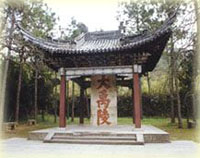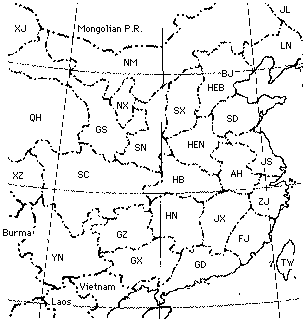
|
Go to China Resources page
Go to Jordan's main page. Go to previous file, next file. |
Content Revised 2008-05-27 File last modified: |

 |
| Putative tomb of Yǔ the Great in Zhèjiāng Province, which claims him as a native son, whethr or not he really existed. |
Dates in all of this are quite impossible to pin down with accuracy, although there are some traditional numbers. Following the traditional numbers, the Xià Dynasty would have extended from 2207 to 1766 BC, but more recent guesses would date the Xià Dynasty slightly later, from about 2100 to about 1600. According to the Chinese government's "Xià, Shāng, and Zhōu Dating Project" 夏商周断代工程, the Xià Dynasty probably began about 2070 BC.
So far there is no direct archaeological evidence for a dynasty of this name —that is to say, no inscriptions have turned up from this period with the word "Xià" on them. That's hardly surprising, since we have no inscriptions from this period of any kind. But obviously there is archaeological evidence of society along the Yellow River at this period in regions where later texts tell us the Xià was located. The archaeological horizon referred to as Lóngshān 龙山 (named after an archaeological site of the same name) might include the period associated with Yáo and Shùn. By Sīmǎ Qiān's time the phrase "Three Dynasties" 三代 was in use and referred to the Xià (period 02) and its two successors, the Shāng 商 (period 03) and the Zhōu 周 (period 04).
The later Shāng and Zhōu dynasties have been archaeologically confirmed and interpreted as something we can reasonably call states. As their predecessor, the Xià may also have been quite state-like. A number of archaeological sites seem to fall into this period and to be located in what might have been the terrain ruled by a Xià royal house. Most of them are located in or near the modern city of Luòyáng 洛阳 in Hénán (HEN) Province and in the southern part of Shānxī (SX) province.
The Yellow river flows out of the mountains of western China and then makes a series of abrupt turns in a kind of box. Most of the archaeological action takes place at the lower-right-hand corner of the box, where the river, flowing southward, suddenly turns eastward again and heads across the central plain to the sea. As it is heading down the right hand side of the "box," the river forms the border between the province of Shǎnxī 陕西 (SN "west of the gorge") and Shānxī 山西 (SX "west of the mountains").
(You can click on the map below to toggle the rivers on and off. The map uses the official Chinese government povince abbreviations. For a full list of province names, click here.)(Because English writers do not mark tones, Shǎnxī and Shānxī end up looking alike, so an extra vowel is arbitrarily written into the former one to provide a difference: "Shaanxi" [SN "west of the gorge"] on the west of the river, "Shanxi" [SX "west of the mountains"]on the east. On this web site, I do that too, even though I also mark the tone: Shǎanxī in contrast to Shānxī.)

The province of Shǎanxī (SN) continues on the south side of the bend in river. But the province of Shānxī (SX) does not. To the south of the east-west section of the river, across from Shānxī, lies the province of Hénán 河南 (HEN "south of the river"). A great many archaeological sites are found both on the north (Shānxī [SX] side) and south (Hénán [HEN] side) of the river. (A little further along the course of the river the provincial boundary heads north so that Hénán lies on both sides of of the river. Eventually the river, itself bending gently to the north, crosses from Hénán into Shāndōng 山东 (SD "east of the mountains") Province and then to the sea.
Shāndōng Province includes a large peninsula that sticks out from the coastline. It slants upward slightly, and a similar peninsula dangles southward from Liáoníng 辽宁 Province (LN). Together they frame the Bóhǎi Sea 渤海. In antiquity, as at the present time, the Yellow River emptied into the Bóhǎi Sea 渤海 to the north of Shāndōng. In the Yuán 元 and Míng 明 dynasties [periods 19 and 20], however, the course of river shifted to empty into the Yellow Sea 黄海 on the south side of Shāndōng Province, causing catastrophic floods as it changed course southward and then back again.
A smaller river, the Wèi 渭水, with various tributaries, flows eastward from central Shǎanxī (SN) and feeds into the Yellow River just at the point where the Yellow River turns from south-flowing to east-flowing and moves away from the Shǎanxī border. A great many early archaeological sites are found along the Wèi river. In general, you can think of the Wèi river flowing through Shǎanxī as the "western" end of the Neolithic scene in the Yellow River Basin, as against the "eastern" part lying along the Shānxī-Hénán border.
Now you know.
Several archaeological sites seem candidates as Xià settlements because they are located in about the right place and were occupied at about the right time. They could have fallen within a political system that later Chinese writers called Xià, or they could have been competing little states; there is no way to know. They certainly seem to have shared cultural traits that one might usefully term "Xià civilization" even if they were not all politically united and do not allow us to speak of a "Xià state." Depending upon the degree of centralization, one or another site might (or might not) be reasonably described as a/the "Xià capital." The prime candidate at this time is Èrlǐtóu 二里头, a site in Yǎnshī 偃师 County in Hénán (HEN) Province.
Click here for a listing of major archaeological sites with materials relevant to the long period leading up to and including the Xià.
The majority guess among Chinese researchers at the moment is that Xià may have been the name of a tribal confederation, headed by a dominant kinship based "clan" named Sì 姒, occupying a region in northern Hénéan (HEN) Province and in southern Shānxī (SX) Province, places occupied, according to later records, by people called Xiàhòu 夏后.
Was there a Xià state? In the absence of further archaeological evidence, it is hard to know, but scholarly opinion at present imagines a Xià polity of some kind, perhaps unified at its center, but quite small. However it is conceived of as influencing other small "statelets" surrounding it. Some of these, some of the time, would have been subordinate to the Xià leadership, and would perhaps have offered tribute (as recounted in later texts). Other "statelets" would have engaged in rebellion against Xià dominance or conspired to overturn the Xià entity itself. Something like this is the pattern of the later Shāng Dynasty, and the early part of the Zhōu Dynasty after that, and it corresponds to the behavior of many late Neolithic kingdoms in other parts of the world. China was not really united until the Qín 秦 Dynasty was established in 221 BC, after all, and even then borders with neighboring peoples needed careful attention, so it is surely correct to see early régimes as constantly embroiled in ever shifting systems of confederation and warfare.
Sīmǎ Qiān tells us that Yǔ the Great intended that after his death his position would pass to a man of great virtue named Yì 益, just as he himself had received the "throne" from Shùn because of his own reputation for virtue. However, Yǔ's son Qǐ 启 did battle with Yì, killed him, and succeeded in assuming his father's position of command [reign 02a-2].
Sīmǎ Qiān is not our only later source that seeks to make sense of the Xià tradition. Another work, less securely authenticated, is something called the Bamboo Annals 竹书纪年. From this we learn the names of a succession of Xià monarchs (typically designated by the title wáng 王, usually translated as "king" in English).
From these later writers we learn that long before Qǐ's death, he made sure that his designated successor would be his own son Tàikāng 太康 [reign 02a-3]. Forever after, the normal rule of royal succession in China was from father to son.
Tàikāng did not have an easy time of it, we are told. The realm was attacked by a chieftain named Yì 羿 and his follower Hánzhuó 寒浞, chiefs of a "clan" called the Yǒuqióng 有穷, one of a group of peoples dwelling to the east of the core Xià area, whom later writers usually called "Eastern Barbarians" or Yí 夷.
(Caution: Distinguish: Yì 益, Yǔ the Great's intended successor ≠ Yì 羿, the Yǒuqióng chieftain ≠ Yí 夷, the "Eastern Barbarians.")
It was some 20 years after Tàikāng's death, in the reign of a "king" known as Shàokāng 少康 [reign 02a-7] that the Xià rulers regained the upper hand, and Shàokāng's successor Zhù 杼 [reign 02a-8] succeeded in making the "Eastern Barbarians" subordinate to the Xià.
(That left only the "Northern Barbarians" or Dí 狄, the "Western Barbarians" or Róng 戎 [or Jiāng 姜], and the "Southern Barbarians" or Mán 蛮 for later periods to deal with.)
How did the Xià end? Tradition holds that the last king of the Xià Dynasty was a terrible tyrant named Jié 桀 or Jiéguǐ 桀癸 [reign 02a-18], whose grotesque behavior all but begged his people to overthrow him. There is no particular reason to doubt that Jié was a monster. However the notion of a dynasty falling because of the moral failings of its last monarch is such a routine theme in Chinese historical writing that we do have a right to be suspicious of later descriptions of Jié. (On the other hand, perhaps it was the misbehavior of Jié that led to this handy explanation being used for the fall of later dynastic houses.)
Review Quiz over this page: Quiz 2.
Go to previous file, next file.